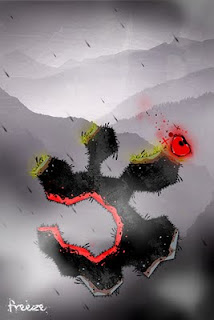 |
| A developing planet, ruled by its overlord |
In a dreadful and decaying universe, who can possibly restore life to two planets? A shirtless gun-trotting man, an angel from the heavens, or a giant robot? Why, none other than a red blob named DEO. This unlikely hero sets out to return life to the cosmos, but inadvertently ends up injecting life into often tiresome dollar platformers.
The core of the game sounds like every other platforming game, but plays out very differently. Tap DEO and move him to the red section at the end of the level by jumping on other platforms. There’s a twist though (quite litterally), since the world is constantly rotating and you must move in accordance with the game’s physics. Landing on a black section of any planet will end DEO’s quest.
The controls are simple and precise. Tapping DEO triggers a small hop, while press and holding the touchscreen increases the distance he will jump when released. DEO’s movements are locked onto one direction, so you never have to worry about turning him around (for better or for worse in some cases). The physics succeed in adding an extra element of intruige to the stages, since they can save you from making a slip-up or cause you to miscalculate the jump. Despite this, the deaths never feel “cheap” because the way the world moves in a particular stage is easy enough to learn after a few deaths.
The biggest “issue” present (which isn’t saying much) is the level design. Each stage slowly rotates and DEO is given opportunites to jump to the next grey section. With 90+ stages, one would expect the difficulty to gradually ramp up, or for new mechanics to be introduced at some point. The closest the game ever comes to challenge is on certain stages where the red goal is not visible. There is potential that remains untapped due to the clear and concise nature of the game that could be added via an update or a harder sequel.
One notabale feature is how the planets constantly develop. After you’ve completed a world (each of which contains many fragments with several levels each), it may stay crusty and dead looking. Gamers wanting something a little extra can watch the planets develop by performing well in the stages, which is not too difficult a task. There are five different layers of crust, leaving a variety of different looks for planets. This is the only part of the entire game that could perplex a player, as it is not entirely clear how many planetary fragments you must redo.
 |
| A still screen doesn’t do this justice |
The simplicity of DEO is both its biggest flaw and its greatest virtue. There are no highscores, achievements, or goals to be sought (save for planetary development). Because such basic designs are utilised, it can never propel itself out of the gravitational pull of the casual realm. On the flip side, nearly everyone can play DEO since it only requires one hand and the mechanics are simple enough that no reading comprehension is required. Within 30 seconds of picking up the game and dying once or twice, you can grasp the game in its entirety. That’s a good thing.
Visually, DEO is among the most striking titles I’ve seen in years. In a melancholy world of black and grey, our red protagonist stands out and exudes life. Still images cannot do its world justice, for the subtle animations breath so much life into the game. Bouncing him onto grey areas causes grass to bloom on the droll environments and awakens subtle colours.
DEO delivers all the basics of a platformer, but polishes them and awakens the experience with unparalleled visuals and sound. Even if the game’s levels aren’t challenging enough for certain seasoned gamers to stay motivated, DEO’s 96 levels are a terrific value at 99 cents. This crimson jelly has a bright future ahead of him.
– Clark A







